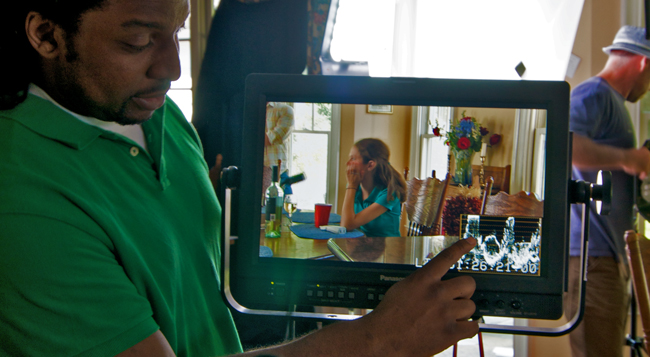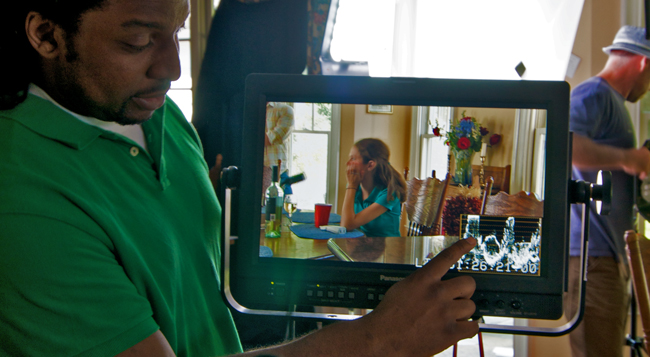
I’ve recently spent a lot of time evaluating our production processes looking for ways to improve efficiency. There were two motivating factors. First, we’ve pretty much abandoned Standard Definition production, relegating it only to live web events where we are streaming the content or where the client demands it. Second, I was working on a new book, Video Made on a Mac: Production and Postproduction Using Apple Final Cut Studio and Adobe Creative Suite with Robbie Carman. In it we try to evaluate ways to efficiently integrate Apple and Adobe software into best practices for production and post.
We discovered a lot along the way, in particular that “field” monitors have taken on a whole new life of usefulness. Here are a few of the things we discovered in the last few months of HD production.
Fix it In Post Should be Forcibly Removed from a Producer’s Lexicon
The fact is cameras these days are capable of producing some beautiful images, but in our experience many shoots are troubled or in the worst-case scenario ruined because no one bothered to view and then adjust the image and sound. Embracing the “Fix it in Post” mentality is the kiss of death when it comes to a quality production.
Of course you may have a huge budget and a dozen people running around ensuring that you getting a perfect image but for most of us this simply is just not possible, but we’re in luck! There are lots of products and some wonderful technology out there to help ensure on-set you can get great results. In this chapter we’ll take a look at on-set monitoring for digital productions. By bringing some of the technology normally associated with post into the production stage, a better production is possible.
Monitors are Essential to Your Success
It used to be that I’d only occasionally glance at the field monitor. I’d treat it more as a “client” monitor and reserve my judgment for occasional glances through the viewfinder. The switch to HD has changed all of this.
The ways that we can monitor on-set these days are numerous, but how do you know which display technology to choose? What characteristics make up a good field monitor? Good on-set monitoring, no matter what its form is a necessity. On-set monitoring is the first step in a lengthy process in evaluating the images you gather. Even if budgets and manpower are tight, you’ll want to push for dedicated on-set monitoring.
LCD Field Monitors Have Arrived
LCD field monitors are a popular choice for many reasons including their physical size, portability, low power consumption and ability to produce full resolution, full raster images. LCD monitors come in a variety of sizes from 8 inches all the way up to 50 inches, additionally they can be rack mounted or placed on a stand.
When looking for a good LCD field monitor be sure to check for a few things:
- Resolution and frame rate support –The best LCD field monitors will be able to support a variety of resolutions up to 1920 x 1080 and do so at a variety of frame rates like 60, 29.97 and 24 fps. Also, when shooting interlaced footage good LCD field monitors should be able to accurately interpret interlacing (they’re natively progressive) by doing on-board processing of the interlaced image. There are several approaches to this but the ones we like best are displays that interpret the interlacing into a progressive frame. Many smaller monitors also allow for 1:1 pixel mapping (which will only display part of the picture). This is a useful way to check focus when shooting a large HD image.
- Input options – In the field you never know what you’re going to need to connect to the display, therefore having a range of input options is must. On modern LCD field monitors these inputs would include SD/HD SDI, SD/HD component video, HDMI and composite video inputs. Having multiple inputs lets you also attach several cameras so you can quickly switch between on a multi-camera shoot.
- Power options – Many LCD field monitors are extremely flexible for the type of power they need. On base level this means the ability to switch between power systems (120/220) but also have the ability to be powered by field battery packs in situations were access to AC power is not available. Don’t let the lack of an extension cord keep you from gauging an accurate picture.
- Viewing Angle –LCD monitors used to be plagued by a viewing angle issue. That is to say that if you viewed the picture from the side the color would look different than if you stood dead center. Fortunately this issue has been solved and many monitors boast viewing angles of up to 178? (no, you can’t view a picture standing behind the monitor yet).
- Built-in Scopes – I recently purchased the Panasonic BT-LH1710 field monitor. One of its best features is that it offers several overlays including an HD Waveform and Vectorscope, which add a level of confidence when gauging image quality.
- Useful Overlays –Monitors are also offering additional overlays these days. Shooting HD but want to protect action for a 4:3 set? Turn on Aspect Markers. Want to check that the camera is straight? Turn on a cross hatch overlay and look for tilt.
- Audio Monitoring – Want to check audio? Many field monitors have built-in speakers so clients can listen in. Concerned about sound? They offer headphone jacks for more private listening. Some monitors (like the aforementioned BT-LH1710) even have Audio Level Meters as an extra precaution for ensuring proper audio is being recorded (you can even turn on peak meters to show clipping).
Calibrating field monitors
You’ve chosen what type of field monitor you are going to use, but without proper calibration even the best monitor won’t do you any good. You can calibrate your monitor of choice in a couple different ways:
- Using built in or feeding Color Bars- Standard color bars are a tried and true method for calibrating monitors. The procedure is the same for every type of monitor.
- Shoot on-set test patterns – While less accurate for a variety of reasons like lighting and lens quality, in a pinch you can shoot test patterns on-set and use those patterns to adjust your field monitors
- Hardware Calibration – Sometimes to get the best, you must pay for it. Calibration engineers do exactly what their job titles imply. A calibration engineer will use dedicated hardware to calibrate your monitor prior to it leaving for a shoot or even on-set using reference standards like those published by SMPTE (Society of Motion Picture and Television Engineers)
The Bottom Line
Monitoring needs to become a part of your everyday production process. While DPs have known this for years, all crew need to start to pay increased attention to monitors on set. In the HD world, image quality is king. The viewfinder can no longer be trusted.

